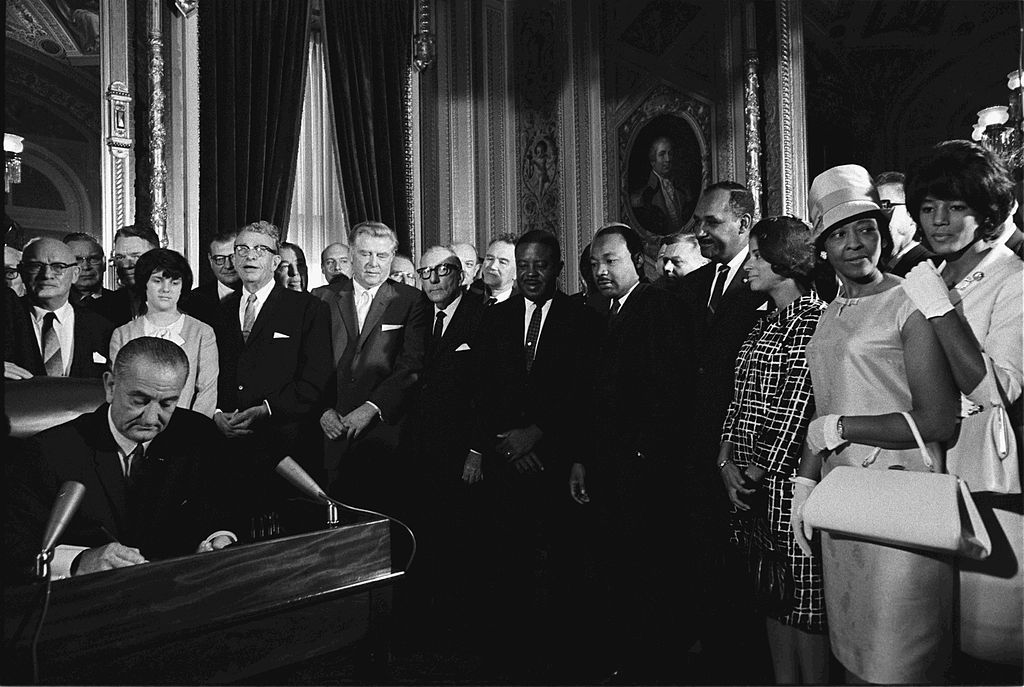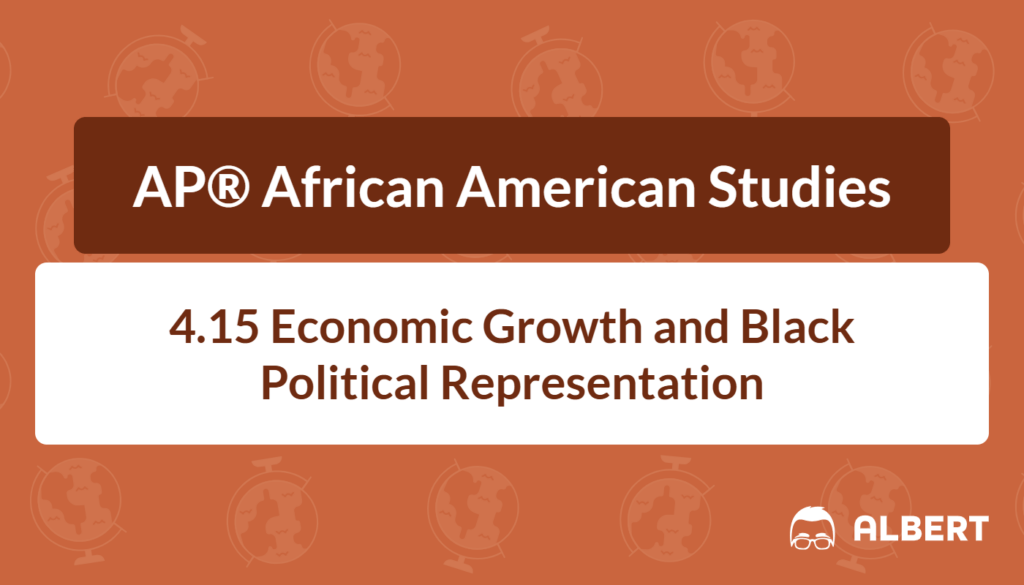What We Review
Introduction
Economic growth and political representation play vital roles in shaping African American communities. Throughout the second half of the twentieth century, African Americans faced discrimination and other challenges that slowed their advancement in wealth and opportunity. Yet, the same period also brought new opportunities to grow strong Black businesses, enroll in higher education, and achieve historic political positions.
This post explores both the hardships and the achievements that shaped Black prosperity and leadership. It begins by looking at how discrimination limited the growth of generational wealth. Next, it examines how the Voting Rights Act of 1965 expanded Black political power. It then highlights major breakthroughs in federal leadership by leaders such as Shirley Chisholm, Colin Powell, and Barack Obama. A separate section focuses on important historical sources, including a commencement address by Colin Powell and portraits symbolizing African American leadership. Step-by-step examples and a handy reference chart at the end help clarify key ideas.
Economic Growth in Black Communities
Hindered Economic Growth
When discussing economic growth in Black communities, it is important to understand how discrimination slowed their progress. Barriers in housing and employment prevented many African Americans from building generational wealth. The result was a gap in household assets and resources that still affects families today.
- For example, in 2016 the median wealth for Black families was about $17,150, whereas white families held a much higher median wealth of $171,000.
- This difference shows why racial wealth disparities do not simply disappear over time: reduced homeownership opportunities, limited access to credit, and lower wages made it harder for Black families to pass on financial stability to future generations.
Promoted Economic Growth
Despite these burdens, African Americans found pathways to success. Desegregation in the 1950s and 1960s improved educational access. Likewise, the urban migration of Black families helped create new business ventures, adding to the rise of the Black middle class in the latter half of the twentieth century.
- Urbanization exposed Black communities to better employment opportunities, while desegregation opened more universities and colleges to Black students. By 2019, 23% of African American adults had earned a bachelor’s degree or higher.
- Increased education, along with expanded social networks in urban areas, paved the way for more Black entrepreneurs to establish businesses. African American–owned restaurants, banks, and media companies followed, providing vital products and services to underserved communities.
Impact of the Voting Rights Act of 1965 on Political Representation
Overview of the Voting Rights Act
The Voting Rights Act of 1965 was a landmark piece of civil rights legislation that transformed American democracy. It outlawed literacy tests, poll taxes, and other tactics used to suppress Black voters, particularly in the South. The law also gave the federal government the authority to oversee voter registration and election practices in states with histories of discrimination—ensuring that voting rights could no longer be denied on the basis of race.

As a result, Black citizens gained a stronger and more protected voice in the electoral process. Voter registration in some Southern states jumped dramatically within a few years. In Mississippi, for example, Black voter registration rose from less than 10% in 1964 to nearly 60% by 1969.
This expansion of political access opened the door for Black Americans to run for—and win—elected office in greater numbers. Between 1970 and 2006, the number of Black elected officials nationwide increased from roughly 1,500 to over 9,000, including city council members, mayors, judges, and members of Congress. These gains marked a major shift in political power and representation, showing how federal legislation can dismantle barriers to democratic participation.
Expansion of Political Representation
With the passage of the Voting Rights Act and the protection of voting access, African Americans steadily advanced their push for representation at every level of government. Over time, Black leaders were elected to city councils, state legislatures, mayoral offices, and seats in Congress—reshaping both local and national dialogues on race, justice, and equity.
The number of Black elected officials grew sixfold between 1970 and 2006, reflecting a significant shift in political power and public attitudes. In 1971 alone, the country witnessed a dramatic increase in Black officeholders, signaling the growing momentum of the post–civil rights era.
Growth from 1,500 to 9,000 Black Elected Officials:
This sharp increase—from approximately 1,500 Black elected officials in 1970 to over 9,000 by 2006—underscored the impact of grassroots organizing and federal protections. Greater representation meant that Black communities could more effectively advocate for civil rights, equitable policies, and community-centered legislation at all levels of government.
Major Advances in Black Federal Political Leadership
Key Figures in Black Political History
Significant Black political leaders helped pave the way for diverse voices in government. One of the most prominent was Shirley Chisholm, who became the first Black woman elected to Congress in 1968. Her courage and determination made her a celebrated figure in African American history.
- Shirley Chisholm championed women’s rights and expanded social programs in education and healthcare.
- She also co-founded the Congressional Black Caucus in 1971, supporting Black candidates in federal, state, and local government roles.
Example: Shirley Chisholm’s Legacy
- She broke barriers by promoting policies that aided marginalized groups.
- Her work built a foundation for future generations of Black women in politics.
The Breakthroughs of the 21st Century
Moving into the twenty-first century, African Americans reached new milestones in federal government. Colin Powell became the first Black Secretary of State in 2001, while Barack Obama achieved a historic victory as President in 2008.
- Obama’s election signaled a major shift in public perception, showing that Americans were prepared to support a Black leader at the highest office.
- Vice President Kamala Harris’s success in 2020 continued this trend, demonstrating an ongoing commitment to representation and diversity in high-ranking positions.
Example: Barack Obama’s Election as the First Black President
- Elected in 2008, he served for two terms until 2017.
- His presidency opened new discussions about race, policy, and the meaning of progress in America.
Sources in Focus
Including historical documents and cultural works enriches our understanding of Black political representation and growth:
1. Commencement Address of General Colin Powell at Howard University (1994):
- In this speech, General Colin Powell emphasized the power of education and leadership.
- It showed how higher education could open doors for African Americans to serve in top government roles, reflecting Powell’s own journey to becoming Secretary of State.
2. Portrait of Former President Barack Obama by Kehinde Wiley (2018):
- This painting by Kehinde Wiley hangs in the Smithsonian’s National Portrait Gallery.
- It symbolizes Obama’s significance as a trailblazer in national politics and conveys the pride connected to his achievement as the first Black president.
3. Portrait of Former First Lady Michelle Obama by Amy Sherald (2018):
- This portrait, also in the National Portrait Gallery, presents Michelle Obama in a distinct style.
- Her role as First Lady expanded the conversation around education, health, and diversity.
- These charts illustrate the ongoing struggles and successes of the Black middle class.
- They clarify the importance of policy decisions that support continued economic progress, highlighting how wealth gaps still hamper development in many Black communities.
Each source connects to the central topic by spotlighting both individual stories and broader community trends. General Powell’s address underscores the value of higher education, the Obama portraits celebrate influential political leadership, and the Brookings charts confirm that the Black middle class is growing but still needs strong policy support.
Conclusion
Economic growth and political power are deeply intertwined in African American history. As seen in the gap between Black and white family wealth, early discrimination set up lasting financial hurdles. However, new opportunities emerged, particularly after desegregation and urban migration boosted the creation of Black-owned businesses and middle-class communities.
Political representation also grew with the passing of the Voting Rights Act of 1965, allowing more African Americans to vote and take office. This paved the way for major figures like Shirley Chisholm, Colin Powell, and Barack Obama, who reshaped how the country views Black leadership. By looking back at these achievements and challenges, it is clear that representation and equitable policies remain crucial for continued progress in Black communities today.
Quick Reference Chart
| Vocabulary | Definition |
| Economic Growth | An increase in the production and consumption of goods and services in an economy. |
| Voting Rights Act of 1965 | A landmark piece of federal legislation in the United States that prohibits racial discrimination in voting. |
| Black Middle Class | A socio-economic class of African Americans who have attained a significant level of income and education. |
| Shirley Chisholm | The first African American woman elected to the United States Congress and a key figure in the fight for Black political representation. |
| Colin Powell | The first African American Secretary of State, serving under President George W. Bush (2001–2005). |
| Barack Obama | The first African American president of the United States, serving from 2009 to 2017. |
These terms and figures demonstrate how economic progress and political representation have evolved in Black communities, reminding everyone of the power of collective action and fair policies to shape the nation’s future.
Sharpen Your Skills for AP® African American Studies
Are you preparing for the AP® African American Studies test? We’ve got you covered! Try our review articles designed to help you confidently tackle real-world AP® African American Studies problems. You’ll find everything you need to succeed, from quick tips to detailed strategies. Start exploring now!
Need help preparing for your AP® African American Studies exam?
Albert has hundreds of AP® African American Studies practice questions, free response, and full-length practice tests to try out.









